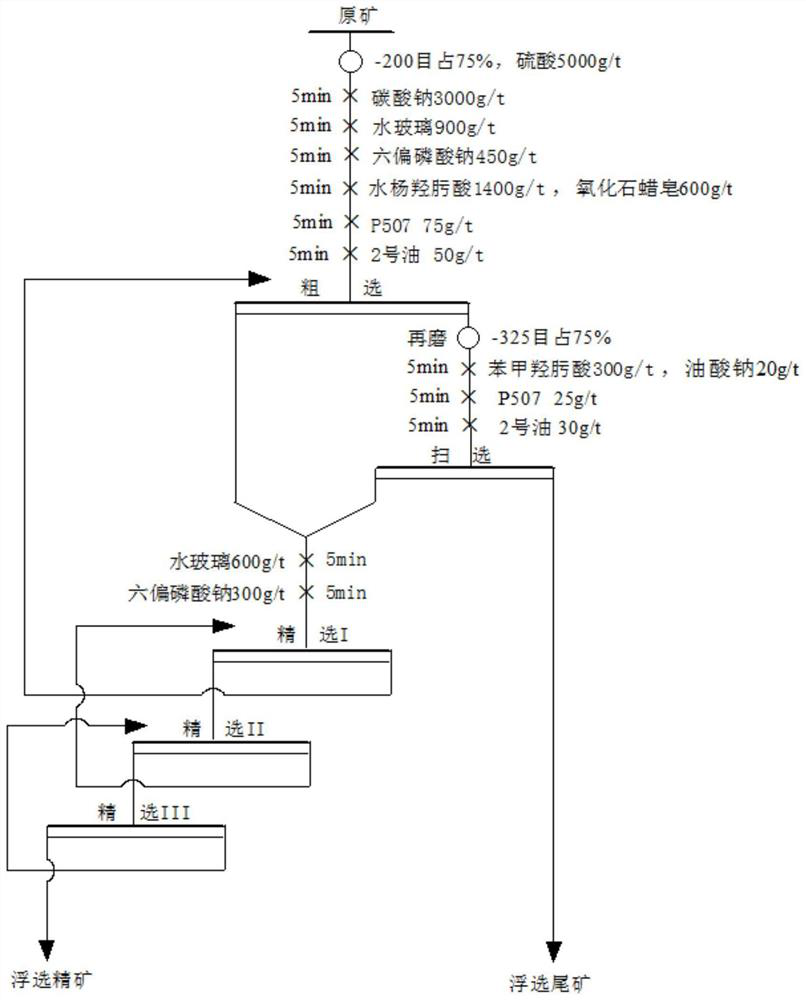A method for flotation of uranium minerals from volcanic rock type uranium ore
A technology for uranium ore and volcanic rock, applied in the field of beneficiation, can solve the problems of reducing the processing capacity of hydrometallurgical ore, reducing production costs, and large consumption of reagents, and achieves the effects of improving flotation recovery rate, reducing production costs, and reducing reagent consumption.
- Summary
- Abstract
- Description
- Claims
- Application Information
AI Technical Summary
Problems solved by technology
Method used
Image
Examples
Embodiment 1
[0037] A volcanic uranium ore is mainly composed of muscovite, quartz, calcite, epidote, rutile, fluorite, apatite, zircon, pitchblende, ilmenite, pyrite, rutile, sphalerite, ilmenite, colloidal molybdenite, galena, magnetite, uranite, etc. There are many minerals such as calcite and fluorite in the ore, resulting in high acid consumption during ore leaching. Uranium mainly exists in the form of independent uranium minerals, including ilmenite, pitchblende and uranite, and a small amount exists in uranium thorite in the form of isomorphism. The uranium grade in the ore is 0.23%.
[0038] (1) Crush the ore particle size to - 5mm, add 2000g / T sulfuric acid during grinding, grind the ore to - 200 mesh, accounting for 55%, adjust the pulp concentration to 20%, transfer it to the flotation tank, and adjust the pulp temperature to 20 ℃.
[0039] (2) Add 3000g / T sodium carbonate into the pulp and stir for 15min under the condition of 2000r / min rotor speed of flotation machine; Add ...
example 1
[0041] The test results of example 1 are shown in Table 1.
[0042] Table 1 example 1 test results
[0043]
[0044]
[0045] It can be seen from table 1 that the combined use of salicylhydroxamic acid and oxidized paraffin soap can play a synergistic role in the limited flotation of uranium minerals in the ore. in addition, the addition of auxiliary collector P507 can enhance the collection capacity of uranium minerals, improve the recovery of uranium, and reduce the amount of salicylhydroxamic acid.
Embodiment 2
[0047] A volcanic uranium ore is mainly composed of muscovite, quartz, calcite, epidote, rutile, fluorite, apatite, zircon, pitchblende, ilmenite, pyrite, rutile, sphalerite, ilmenite, colloidal molybdenite, galena, magnetite, uranite, etc. There are many minerals such as calcite and fluorite in the ore, resulting in high acid consumption during ore leaching. Uranium mainly exists in the form of independent uranium minerals, including ilmenite, pitchblende and uranite, and a small amount exists in uranium thorite in the form of isomorphism. The uranium grade in the ore is 0.23%.
[0048] (1) Crush the ore particle size to - 4mm, add 3000g / T sulfuric acid during grinding, grind the ore to - 200 mesh, accounting for 70%, adjust the pulp concentration to 25%, transfer it to the flotation tank, and adjust the pulp temperature to 30 ℃.
[0049](2) Four groups of experiments were set up to investigate the flotation effect of different inhibitor types and combinations on uranium minera...
PUM
 Login to View More
Login to View More Abstract
Description
Claims
Application Information
 Login to View More
Login to View More - R&D
- Intellectual Property
- Life Sciences
- Materials
- Tech Scout
- Unparalleled Data Quality
- Higher Quality Content
- 60% Fewer Hallucinations
Browse by: Latest US Patents, China's latest patents, Technical Efficacy Thesaurus, Application Domain, Technology Topic, Popular Technical Reports.
© 2025 PatSnap. All rights reserved.Legal|Privacy policy|Modern Slavery Act Transparency Statement|Sitemap|About US| Contact US: help@patsnap.com



